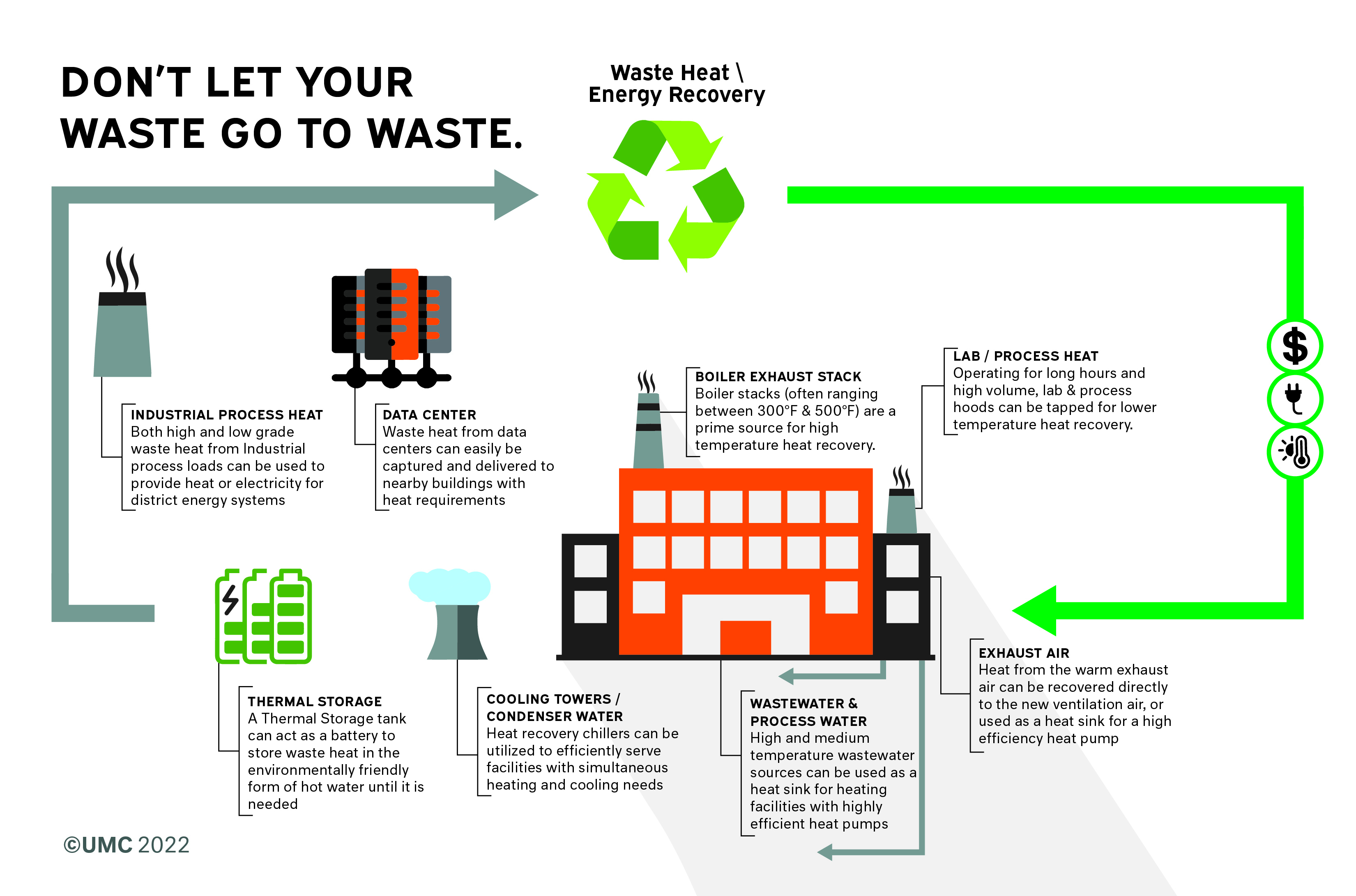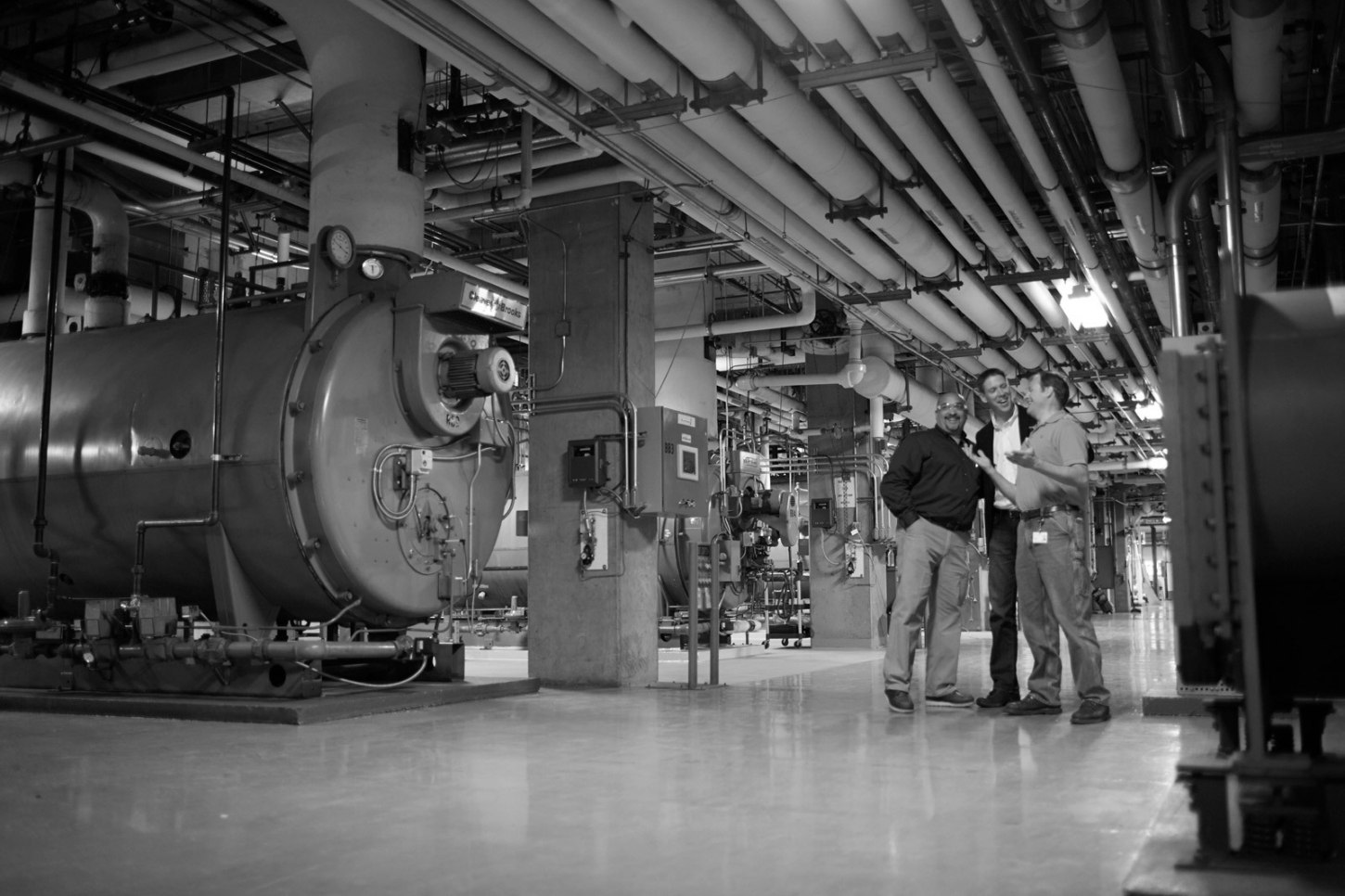Originally featured in PHC News May addition. Click here to read the article.
Waste Not, Want Not
Of all the energy that we produce, we unintentionally waste about 70 percent of it.
Unrecovered waste heat is, well, just wasted, and an expensive waste to pay to heat the sky or pour down the drain. So, wouldn’t you say this remarkable source of “free” energy is worth capturing and repurposing?
Waste heat recovery is the process of identifying an accessible source of waste heat, implementing a heat recovery system and applying the recovered energy back into the system(s) or facility. Waste heat can be found and potentially harvested anywhere that humans produce and or consume energy. Of all the energy that we produce, we unintentionally waste about 70 percent of it.

Where does waste heat come from?
Waste heat sources include industrial processes and energy production, mechanical equipment cooling, warm water discharged into the environment, hot gases discharged into the atmosphere (in other words, from industrial processes and boilers), ventilation/building exhaust discharged into the atmosphere, municipal wastewater and so on.
The quality of the waste heat varies by situation and is typically measured by the temperature of the waste heat, accessibility, economic ability to recover and consistency of supply.
Data centers, for instance, require a significant amount of energy, 24-7, to maintain an optimal server environment, offering remarkable heat recovery opportunities. Moreover, the investment in data center heat recovery can produce an additional source of income for the data center provider. In addition to renting rack space for servers, the heat that the servers produce can be harvested and sold to a nearby campus, facility or district energy system.
For example, the primary source of heat for the Amazon headquarters in downtown Seattle, along with the iconic Spheres, is waste heat sourced from a large data center across the street.
The rejected heat is harvested via a large heat exchanger in the data center facility. The data center’s hydronic cooling system made this approach possible and effective. The recovered heat from the heat exchanger is conveyed through piping under the street to the building’s mechanical spaces.
Saving 4 million kilowatt-hours of electricity each year, this relatively small district energy heat recovery system supports the buildings and even an environment that houses more than 40,000 exotic plants inside the glass spheres. It’s an outstanding example of what can be done with recovered waste heat.
New tech and regs
While waste heat recovery is not a new concept, new technologies are emerging as a result of the urgency to conform to new code and policy changes, battle climate change and keep up with the world’s ever-increasing energy demands.
For example, many jurisdictions in the U.S. are proposing or have already implemented policies that reduce and/or ban fossil fuels in certain new and renovated buildings. Combined with customer demand, these policy and code pushes are prompting additional investments in technology and system innovations to offset our current reliance on fossil fuels. Furthermore, some jurisdictions, such as Seattle, are now requiring heat recovery in high-rise residential buildings, with further codes on the way for heat recovery in commercial buildings.
Heat pumps are a key go-to system when fossil fuels are not an option. While not commonly thought of as heat recovery units, heat pumps, by design, utilize waste heat by transferring heat in one area of a facility/campus with a cooling demand to another area with a heat demand. Indeed, the economy of scale from sharing reclaimed waste heating among several connected buildings is a unique opportunity of district heating.
There is also a trend in building codes requiring that heat pumps be used to provide the hot water source in certain buildings. Seattle requires that buildings with central service water heating systems greater than 15 kW shall not use fossil fuel combustion or electric resistance. While there are exceptions, the primary source of hot water will now primarily come from heat pumps.
Reclaiming wastewater heat
Reclaiming wastewater heat before it goes down the drain is another key source of waste heat. Wastewater from domestic, industrial and commercial developments maintains considerable amounts of thermal energy after discharging into the sewer system. In the U.S., 350 billion kWh of hot water is flushed away annually. Very little of this resource is currently recovered and it presents a significant opportunity.
False Creek Wastewater Facility in Vancouver, Canada, for example, recovers heat from wastewater to serve 5.2 million square feet of neighboring building space, while eliminating more than 60 percent of greenhouse gas pollution associated with heating the buildings.
The facility uses a wastewater filtration developed by SHARC Energy. The company’s versatile high efficiency wastewater filtration systems can serve one building or a full district system. This technology extracts and transfers thermal energy from a building’s waste graywater to preheat a holding tank for the building’s next needs for hot water. Only heat from sink and shower drains transfers in this closed-loop system – wastewater, gray water and fresh water never mix.
And since it’s a heat pump at its core, the SHARC system can also work in reverse, cooling a building by moving its heat into the wastewater system.
Recovery options
Waste heat recovery resources can be used immediately as cool or warm air or water. Recovered heat can also be stored in thermal storage tanks for future needs on-demand. Such “thermal battery” systems rank top-notch with other methods of energy storage, at 85-95 percent efficiency compared to pumped hydropower’s 70-80 percent efficiency. Waste heat recovery and storage in the built environment is a unique energy efficiency measure, cost-effectively storing clean electricity to be reclaimed again and again.
Some of the simplest heat recovery options are available right in your customer’s facility.
Exhaust air streams (at an average 70 degrees) and facility wastewater (which can often range from 50 degrees to 70 degrees) make excellent heat sinks for rapidly improving heat pump technology. And heat recovery chillers, when coupled with thermal storage, provide a great option to deliver cooling during the daytime while storing the resultant waste heat for days at time until it is needed. This is extremely viable in an environment where heating is needed in the morning and cooling in the afternoon.
Waste heat recovery opportunities are all around us.
Today, we’re designing most new buildings to have well-tuned internal waste heat recovery systems, but most old ones need help, too. Deep efficiency and resiliency measures sound like a tall order for old buildings, but we can do this. A well-planned, phased approach for long-term lifecycle benefits is key to affordable infrastructure renewal.
What should mechanical contractors be doing?
How often have you been driving down the road on a cold afternoon when you see great plumes of white condensation streaming from an industrial site? That’s a huge plume of waste heat! A key question is how to capture that heat and then transfer it to a site (often several miles away) that has a need. This is the Holy Grail of waste heat!
Mechanical contractors and, specifically, design-build contractors, need to understand the concepts and implementation strategies for waste heat recovery.
Waste heat recovery was once a value-added option to increase efficiency, reduce lifecycle cost and carbon, but will soon become a necessity to comply with code, policy and customer demand. Our always-creative industry needs to maintain this level of innovation and proactively promote, sell, and integrate waste heat recovery concepts into our customers’ facilities. The result is win-win.
Jerry Bush is CEO and a 30-year veteran of UMC, founded in 1920 to serve the Pacific Northwest as a mechanical contractor. Bush is a past president and active member of the Mechanical Contractors Association Western Washington. He can be reached at jbush@umci.com.
Questions or Comments?
For media inquiries or related questions, please contact info@umci.com
